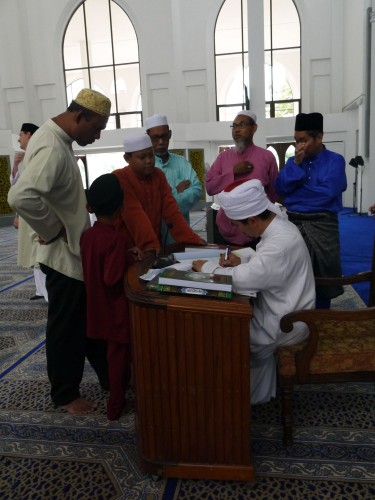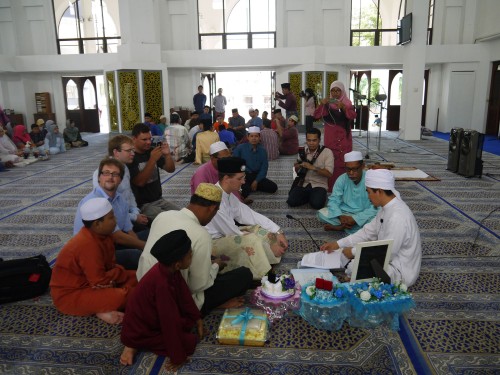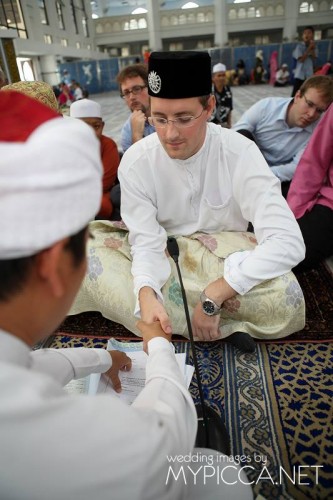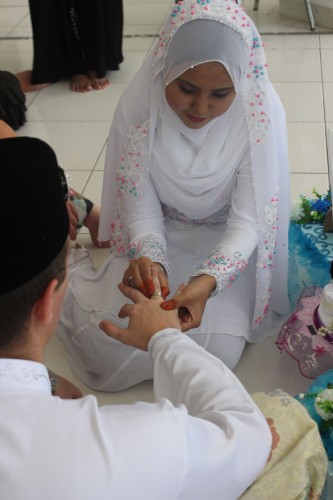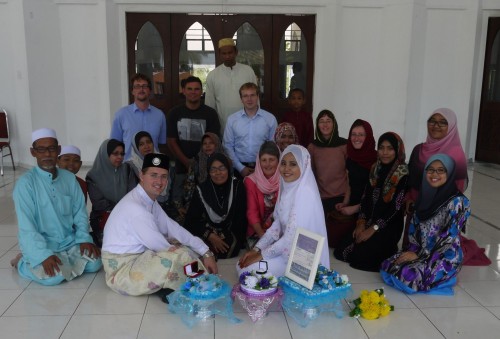Nach all den ganzen Vorgeschichten kommen nur mehr Informationen zu der Hochzeit selbst. Beginnen möchte ich mit dem Samstag, der offiziellen muslmischen Hochzeitszeremonie, die in Malaysia “Akad Nikah” genannt wird.
Malaysia als Land verschiedener Religionen Rassen kennt unterschiedliche Zeremonien abhängig vom Hochzeitspaar. Viele Paare werden im Standesamt von einem Standesbeamten getraut. Bei einem muslimischen Ehepartner findet jedoch stets eine muslimische Hochzeitszeremonie statt.
Traditionell findet diese im Hause der Eltern der Braut statt, heutzutage werden die meisten Paare jedoch in der Moschee verheiratet. Da ich kein malaysisch spreche, haben wir uns für eine englisch-sprachige Zeremonie registriert. Diese kann dann in dem entsprechenden Bundesstaat nur in genau einer Moschee stattfindet, der Masjid Al-Sultan Ismail Petra im Stadtteil Kubang Kerian. Dies ist auch die größte Moschee des Bundesstaates und hat eine sehr schöne Architektur.
Da der Termin kurz nach den Feiertagen stattfand, gab es sehr viele Paare, die am selben Termin geheiratet haben. So wurden dann auch mehrere Paare auf dieselbe Uhrzeit bestellt und man hat dann entweder ausgehandelt, wer beginnt, oder es wurde nach „First Come, First Serve“ festgelegt. Ich selbst habe dann gesagt, dass ich nicht unbedingt der Erste sein muss, sondern mir erst einmal gerne eine Zeremonie eines anderen Paares ansehen möchte. So waren wir dann das 2. Hochzeitspaar bei diesem Imam (islamischer Geistlicher). Parallel waren noch andere Imame dort, so dass teilweise auch mehrere Hochzeiten gleichzeitig stattfanden. In Summe habe ich dort bestimmt mindestens 20 Brautpaare an dem Vormittag gezählt.
Für eine Hochzeit in Malaysia sind prinzipiell nur 4 bzw. 5 Leute notwendig:
- Der Imam, der die Hochzeit am Ende dokumentiert und an die islamische Behörde weitergibt zur Eintragung ins Eheregister sowie Ausstellung der offiziellen Eheurkunde
- Der Wali, der rechtliche Vertreter der Braut. Dieser nimmt die Verheiratung vor.
Vom Prinzip her ist es der Vater der Braut. Dieser kann jedoch diese Tätigkeit auch abgeben, wenn er selbst zu nervös dazu ist.
So hat auch mein Schwiegervater dieses Amt lieber an den Imam der Moschee abgetreten. - Der Bräutigam
- 2 Trauzeugen. Diese müssen malaysische Staatsbürger, mindestens 21 Jahre alt sowie Muslime sein.
Da wir eine englische Zeremonie hatten, müssen diese auch sehr gut Englisch sprechen und versehen können.
Die Zeugen haben dann Hidaya’s Eltern ausgesucht. So hatten wir am Ende dann 2 Lehrer als Zeugen.
Viele werden sich bei der Aufzählung jetzt wundern, dass die Braut nicht aufgeführt ist. Diese ist nach malaysischem Recht bei der Zeremonie in der Tat nicht erforderlich. Die Hochzeit kann vom Wali auch in Abwesenheit der Braut durchgeführt werden. Hidaya war aber natürlich auch bei der Zeremonie dabei.
Neben den genannten Personen ist der Besucherkreis eher klein. So beschränkt man sich auf die direkten Verwandten sowie enge Freunde.
Nachdem das erste Brautpaar soweit durch war, gingen die Vorbereitungen für unsere Zeremonie los. Zuerst hat der Imam gemeinsam mit Hidaya’s Vater und den Trauzeugen die vorläufige Heiratsurkunde ausgefüllt. Anschließend hat er Hidaya gefragt, ob sie mit der Heirat einverstanden ist und sie auf dem Formular auch noch unterschreiben lassen.
Als die Dokumente vorbereitet waren, ging dann die Zeremonie auch los. Besonders wichtig dafür ist die Sitzordnung. So sitzt der Bräutigam direkt gegenüber dem Wali. Direkt neben dem Bräutigam sitzen die Beiden Trauzeugen, die am Ende die Korrektheit der Heirat bestätigen. In etwas Abstand hinter dem Bräutigam folgen dann die männlichen Besucher der Hochzeit. Die Braut sowie die weiblichen Besucher folgen in einigen Metern Abstand.
Was gesprochen wird, bekommt so gar nicht jeder mit. Immerhin haben wir den Imam überzeugt, dass wir die Zeremonie per Mikrofon machen wollen. Aber auch damit kam wohl nicht alles an. Ich habe dann aber auch meine Kamera auf das Stativ gestellt und die Zeremonie auf Video aufgenommen. Der Ton ist bisher auch noch nicht optimal, aber ich hoffe, dass ich das Video noch nachbearbeiten kann, so dass man alles versteht, und zusätzlich auch noch in Untertiteln nachlesen kann.
Als dann alles vorbereitet war, hat der Imam mich als Bräutigam begrüßt und anschließend einige muslimische Grüße sowie ein Gebet gesprochen. Danach kam die eigentliche Verheiratung dran. Hier sagt der Imam sinngemäß „Ich verheirate Dich mit … mit einem Brautgeld in Höhe von …“. Der Bräutigam antwortet dann mit „Ich akzeptiere die Heirat mit … mit einem Brautgeld in Höhe von …“. Wenn diese 2 Sätze ausgetauscht wurden und der Imam sowie die Zeugen damit einverstanden sind, ist man rechtsgültig verheiratet.
In der Zeremonie verliest der Bräutigam dann noch ein Eheversprechen, dass er sich immer gut um seine Frau kümmern wird. Sowie einige rechtliche Fälle, in denen sich die Ehefrau später scheiden lassen kann (z.B. wenn man der Frau für 4 Monate nichts zum Essen gibt). Laut muslimischem Recht kann sich der Mann recht einfach scheiden lassen, die Frau braucht aber einen sehr wichtigen Grund dafür.
Nachdem dies erledigt war, wurde die Beurkundung der Ehe durchgeführt. Zuerst musste ich unterschreiben, anschließend die beiden Trauzeugen und zu Schluss noch der Imam. Damit war die offizielle Zeremonie nach weniger als 10 Minuten auch schon abgeschlossen und die Gäste haben ihre Glückwünsche überbracht.
Anschließend sind wir vor den Eingang der Moschee gegangen um den Platz im inneren für das nächste Brautpaar frei zu machen. Denn die Zeremonie zum Austausch der Ringe gehört nicht mehr zum offiziellen Teil sondern wird anschließend ausgeführt.
Hidaya bekam von mir dann auch gleich 2 Ringe angesteckt. So ist Gold für Frauen in Malaysia sehr wichtig und eine Frau muss zur Hochzeit unbedingt einen Ring aus Gold bekommen. Im Gegensatz dazu dürfen Männer dort kein Gold tragen. Da ich der deutschen Kultur folgenden aber ein passendes Ringpaar haben wollte, habe ich noch Ringe aus Palladium mit Gravur des Namens und Datums aus Deutschland mitgebracht.
Nach dem Austausch der Ringe standen dann noch Bilder mit der Familie und Gästen auf dem Programm. Anschließend sind dann die anderen zurückgefahren zum Mittag essen, während Hidaya und ich mit dem bestellten Fotografen noch in der Moschee geblieben sind um dort noch einige Bilder aufzunehmen.
In diesem Beitag vorab einmal ein paar Bilder, die meine Mutter, mein Bruder oder Hidaya’s Geschwister aufgenommen haben. Die Bilder des Fotografen sind noch in Malaysia. Wenn Hidaya hier ist und ich alle Bilder habe, werde ich nochmal einen Beitrag mit den schönsten Bildern einstellen.
English – Akad Nikah – Malay wedding ceremony
After many other stories on the preparation and the days before the wedding I’m now starting with some information on the wedding itself. Starting with the “Akad Nikah”, the Muslim wedding ceremony which took place on Saturday.
Malaysia is a country on many religions and races and depending on this there’re various types of wedding ceremonies. Many couples are getting married at a registrar or city hall. Though for any Muslim partner it will always be a religious ceremony.
Different than in Germany, it will only be this ceremony and this is the full legal wedding. People getting married in Germany always will have to marry at city hall. The religious ceremony at a church is optional and has no legal impact.
Traditionally, this ceremony takes place at the house of the parents of the bride though nowadays most couples are getting married at a mosque. As I don’t speak Malay (but I want to start learning it once Hidaya is here) we opted for a English language ceremony. Thus, the ceremony took place at the Masjid Al-Sultan Ismail Petra, the largest mosque in the state and with a very nice architecture.
As the wedding took place shortly after Hari Raya it was high season for weddings and many other couples got married at the same day and place. So it was multiple couples there at the same time and they got processes like “First Come, First Served” or by discussing the order of the ceremonies. I said I would prefer seeing another ceremony first before it was our turn. So we got married at the second couple for this Imam. There also have been other Imams at the mosque and weddings also have been done in parallel, like one couple on the left and the other on the right side of the mosque. I guess I saw more than 20 couples while being in the mosque that morning.
For a wedding in Malaysia it requires only 4 or 5 people to be present:
- The Imam who is documenting the wedding and is forwarding the forms for the registration. He will also issue a temporary wedding certificate.
- The Wali, the legal guardian of the bride who will solemnize the wedding.
That’s in general the father of the bride though he may hand over this take to anyone else.
My father-in-law also decided that he feels more comfortable if the Imam of the mosque is taking over this role - The groom
- Two witnesses for the wedding. They have to be Malaysian citizens, at least 21 years old and Muslims.
As we had an English ceremony the witnesses also needs to have good English skills to understand all the Wali and the groom are saying.
The witnesses had been selected by Hidaya’s parents.
Some may wonder why the bride is not listed under the required participants. According to Malaysia law the presence of the bride at the ceremony is not mandatory. The Wali may solemnize the wedding also if she’s absent. Though for sure Hidaya attended the ceremony and I would not want any ceremony without having the bride at my side.
Besides the people mentioned the ceremony is rather small. Only close family and some close friends will attend this event. So quite similar to the legal wedding at the “Standesamt” (department of the city hall responsible for weddings in Germany) here.
After the first ceremony has been completed our ceremony was prepared. The Imam prepared all the forms together with Hidaya’s father and the witnesses. Afterwards the father asked Hidaya whether she agrees to the marriage and she got to sign the form.
The ceremony started once all preparations have been completed. Quite important for this is the proper seating arrangements. The groom sits opposite the Imam. The two witnesses are sitting left and right of the groom so that they can hear everything and later confirm the correctness of the marriage. All male guests are seating with a small distance behind the groom and witnesses. The bride and all female guests are sitting at the side with a distance of several meters.
With this arrangement, most guests won’t hear a single word of the ceremony. Luckily we could agree with the Imam to use the microphone for the ceremony so the people could at least hear part of the ceremony but not all. In addition I put my camera on a tripod and took a movie of the full ceremony though need to edit it and try to improve the audio. Hope afterwards people can see the ceremony and understand the audio or read the subtitles.
After all preparations have been completed the Imam welcomed me and gave some Muslim wishes and prayers. Then the solemnization started. He said like “I solemnize your marriage with …”. Then the groom replies “I accept the marriage with …”. After these 2 sentences are completed and accepted by the witnesses the couple is officially married.
Afterwards the groom will read the taaliq, some type of wedding vow to always take good care of the bride. And some legal cases allowing the bride to get divorced later (e.g. not giving basic necessities to her for 4 months). According to Muslim law the man can get divorced without much reason. But the woman needs to prove a good reason for it.
Then, the forms have been completed. I signed first, then the two witnesses and at the end the Imam. The official ceremony was then completed after less than 10 minutes and the guests gave their regards to the newly wed.
We then went outside of the main prayer hall to make space for the next couple. Since the exchange of the rings also takes place at a wedding in Malaysia but is no part of the official ceremony.
Hidaya even got 2 rings from me. Gold is very important to women in Malaysia and it’s like a must for a bride to get a golden ring after the Akad Nikah. In contrast, men are not allowed to possess or wear any gold item. And I wanted to follow the German culture where the couple has a pair of matching rings. So I brought rings made of Palladium from Germany with our names and the wedding day engraved.
Then it was time to take many pictures together with the family and guests. Hidaya and I stayed at the mosque with our photographer to take more pictures while the others drove back to the parents’ house for lunch. Here just some pictures taken by my mum, my brother or Hidaya’s siblings. The pictures of the photographer are still with Hidaya and too big to transfer by E-Mail. Thus I have to wait until Hidaya is here but then will put some selection of nice pictures here on my blog.
